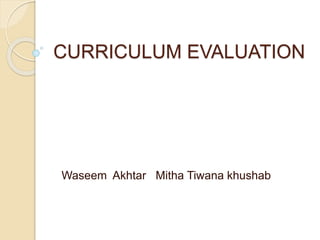
WASEEM AKHTAR MITHA TIWANA.3.pptx
- 1. CURRICULUM EVALUATION Waseem Akhtar Mitha Tiwana khushab
- 2. Unit 7 Nature and Function of Curriculum Evaluation Types of Curriculum Evaluation Techniques of Curriculum Evaluation Tools of Curriculum Evaluation
- 3. Nature and Function of Curriculum Evaluation Evaluation is the process of determining the value of something to which goals are being achieved. It is a process of making a decision or reading a conclusion. It involves decision making about student performance based on information obtained from an assessment process. Assessment is the process of collecting information by reviewing the product of student work, interviewing, observing, and testing.
- 4. Nature and Function of Curriculum Evaluation It is a continuous process, helps in making decisions about student, teaching learning techniques, facilities, objectives to be realized. It helps in to clarify objectives and also to know the extent of objectives achieved. It leads to improvement of instruction and the teaching learning process motivates the student, determine the students level of knowledge and skills.
- 5. Nature and Purpose of Evaluation The final judgment taken on the basis of assessment in a teaching-learning process is called evaluation. The concept of Evaluation is broad. Evaluation deals with the final task of determining competency among learners. Evaluation is a continuous process. Observation plays an important role in the process of Evaluation. Along with intellectual development, it deals with physical, mental, social, emotional and all-round development of learners
- 6. Purpose of Evaluation: To determine the relative effectiveness of the programmed in terms of students’ behavioral output. To make reliable decisions about educational planning. Evaluation describes how to assess the nature, impact and value of an activity through the systematic collection, analysis and interpretation of information with a view to making an informed decision.
- 7. Purpose of Evaluation: To identify students’ growth or lack of growth in acquiring desirable knowledge, skills and attitudes. To help teachers determine the effectiveness of their teaching techniques. To motivate students to learn more as they discover their progress or lack of progress in given tasks.
- 8. Purpose of Evaluation: To encourage students to develop a sense of discipline and systematic study habits. To provide educational administrators with adequate information about teachers’ effectiveness and school need. .
- 11. Formative evaluation It is used to monitor the learning process of students during the period of instruction. It provides continuous feedback to both teacher and student concerning learning successes and failure while instruction is in process. Feedback to students provides reinforcement of successful learning and identifies the specific learning errors that need correction.
- 12. Formative evaluation Feedback to teacher provides information for modifying instruction and for prescribing individual and group remedial work. It aims at improvement of instruction. It is concerned with the process of development of learning It is a positive evaluation because it attempts to create desirable learning goals and tools for achieving such goals.
- 13. Types of formative evaluation Diagnosing- It is concerned with determining the most appropriate method or instructional materials conducive to learning. Placement- It is concerned with finding out the position of an individual in the curriculum from which he has to start learning. Monitoring- It is concerned with keeping track of the day today progress of the learners and to point out changes necessary in the methods of teaching instructional strategies etc.
- 14. Characteristics of Formative evaluation It is an integral part of learning process. It occurs frequently during the course of instruction. Its results are made immediately known to the learners. it may sometimes take teacher’s observation only. It reinforces learning of the students.
- 15. Examples of formative evaluation Monthly test Class test Periodical assessment Teacher’s observation etc.
- 16. Summative Evaluation It is done at the end of the course of instruction to know to what extent the objectives previously fixed have been accomplished. Its main objective is to assign grades to the pupils. It indicates the degree to which the students have mastered the course content. It helps to judge the appropriateness of instructional objectives.
- 17. Characteristics of summative evaluation It is terminal in nature as it comes at the end of the course of instruction. It is judgmental in character in the sense that it judges the achievement of pupils. It views evaluation ‘as a product’, because its chief concern is to point out the levels of attainment. It can not based on teacher’s observation only.
- 18. Characteristics of summative evaluation It reinforces learning of the students who has learnt an area. It may or may not motivate the learners. Sometimes it may have negative effects.
- 19. Examples of summative evaluation Traditional school and university examinations. Standardized tests. Teacher made tests. Practical and oral tests.
- 21. Diagnostic evaluation The term diagnosis has been taken from medical profession. Difficulties in learning occur at all levels and among pupils of both high and low mental ability. Like a doctor teacher uses similar techniques to diagnose the relative strength and weaknesses of pupil in specific area of study, analyze the causes for the same and then gives remedial measures as per necessity.
- 22. Features The diagnostic test takes off where formative test leaves off It is a means by which an individual profile is examined and compared under certain norms or criteria. It is more intensive and act as a tool for analysis of learning difficulties. It is more limited to low ability students
- 25. References Guba, E.G. and Stufflbeam, D. L. (1970). Evaluation: The process of stimulating, Aiding and Abetting Insightful Action in Smith, C.B (ed) Monograph series in Reading Education No. (1 June 1970). Indian University. Hameed (2002) A comparative curriculum review for inclusive schools, Journal of special education, Volume-2, Punjab University, Lahore. Gatefield R.A (2005) Curriculum evaluation at secondary level, Educational research review, Volume-3, University of Malaysia.